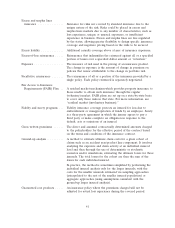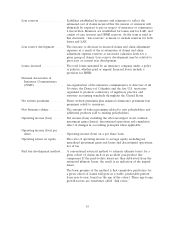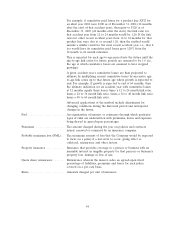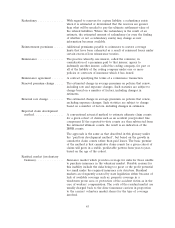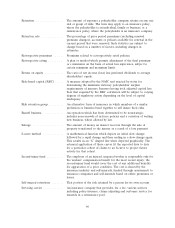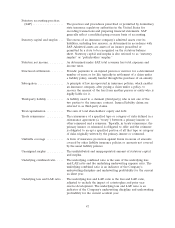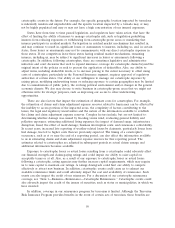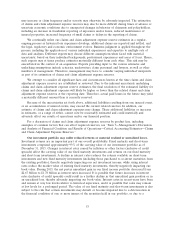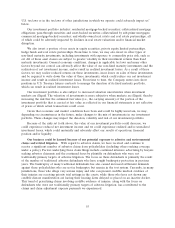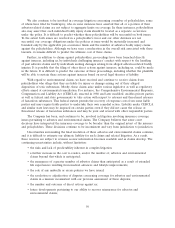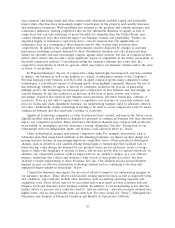Travelers 2015 Annual Report Download - page 50
Download and view the complete annual report
Please find page 50 of the 2015 Travelers annual report below. You can navigate through the pages in the report by either clicking on the pages listed below, or by using the keyword search tool below to find specific information within the annual report.catastrophic events in the future. For example, the specific geographic location impacted by tornadoes
is inherently random and unpredictable and the specific location impacted by a tornado may or may
not be highly populated and may or may not have a high concentration of our insured exposures.
States have from time to time passed legislation, and regulators have taken action, that have the
effect of limiting the ability of insurers to manage catastrophe risk, such as legislation prohibiting
insurers from reducing exposures or withdrawing from catastrophe-prone areas or mandating that
insurers participate in residual markets. Participation in residual market mechanisms has resulted in,
and may continue to result in, significant losses or assessments to insurers, including us, and, in certain
states, those losses or assessments may not be commensurate with our direct catastrophe exposure in
those states. If our competitors leave those states having residual market mechanisms, remaining
insurers, including us, may be subject to significant increases in losses or assessments following a
catastrophe. In addition, following catastrophes, there are sometimes legislative and administrative
initiatives and court decisions that seek to expand insurance coverage for catastrophe claims beyond the
original intent of the policies or seek to prevent the application of deductibles. Also, our ability to
adjust terms, including deductible levels, or to increase pricing to the extent necessary to offset rising
costs of catastrophes, particularly in the Personal Insurance segment, requires approval of regulatory
authorities of certain states. Our ability or our willingness to manage our catastrophe exposure by
raising prices, modifying underwriting terms or reducing exposure to certain geographies may be limited
due to considerations of public policy, the evolving political environment and/or changes in the general
economic climate. We also may choose to write business in catastrophe-prone areas that we might not
otherwise write for strategic purposes, such as improving our access to other underwriting
opportunities.
There are also factors that impact the estimation of ultimate costs for catastrophes. For example,
the estimation of claims and claim adjustment expense reserves related to hurricanes can be affected by
the inability to access portions of the impacted areas, the complexity of factors contributing to the
losses, the legal and regulatory uncertainties and the nature of the information available to establish
the claims and claim adjustment expense reserves. Complex factors include, but are not limited to:
determining whether damage was caused by flooding versus wind; evaluating general liability and
pollution exposures; estimating additional living expenses; the impact of demand surge; infrastructure
disruption; fraud; the effect of mold damage; business interruption costs; and reinsurance collectability.
In recent years, increased late reporting of weather-related losses by claimants, particularly losses from
hail damage, has led to higher costs than we previously expected. The timing of a catastrophe’s
occurrence, such as at or near the end of a reporting period, can also affect the information available
to us in estimating claims and claim adjustment expense reserves for that reporting period. The
estimates related to catastrophes are adjusted in subsequent periods as actual claims emerge and
additional information becomes available.
Exposure to catastrophe losses or actual losses resulting from a catastrophe could adversely affect
our financial strength and claims-paying ratings and could impair our ability to raise capital on
acceptable terms or at all. Also, as a result of our exposure to catastrophe losses or actual losses
following a catastrophe, rating agencies may further increase capital requirements, which may require
us to raise capital to maintain our ratings. A ratings downgrade could hurt our ability to compete
effectively or attract new business. In addition, catastrophic events could cause us to exhaust our
available reinsurance limits and could adversely impact the cost and availability of reinsurance. Such
events can also impact the credit of our reinsurers. For a discussion of our catastrophe reinsurance
coverage, see ‘‘Item 1—Business—Reinsurance—Catastrophe Reinsurance.’’ Catastrophic events could
also adversely impact the credit of the issuers of securities, such as states or municipalities, in which we
have invested.
In addition, coverage in our reinsurance program for terrorism is limited. Although the Terrorism
Risk Insurance Program provides benefits in the event of certain acts of terrorism, those benefits are
50



